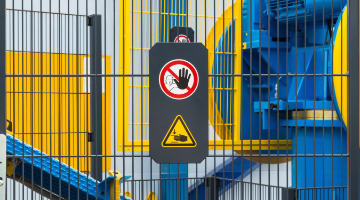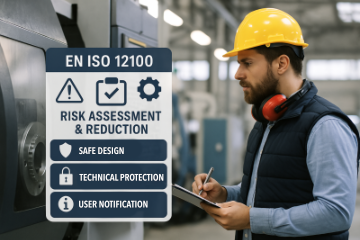Risk Assessment
EN ISO 12100 defines the standard for "Machine Safety – Risk Assessment and Risk Reduction for Machinery." It serves as a fundamental guideline for machine safety across Europe and many other countries.
Here are some key points about EN ISO 12100:
Here are some key points about EN ISO 12100:
- 1. Purpose: EN ISO 12100 provides a framework to reduce safety risks during the design, manufacturing, and use of industrial machines. Its main goal is to ensure safe working conditions for operators, maintenance personnel, and others nearby.
- 2. Scope: This standard applies to all industrial machines and is suitable for any type of business or industry.
- 3. Risk Assessment: The standard outlines a process for identifying potential hazards, analyzing their causes, and determining appropriate risk reduction measures.
- 4. Risk Reduction: EN ISO 12100 details strategies and techniques to mitigate or eliminate risks during machine design and operation.
- 5. Machine Documentation: It emphasizes the importance of documenting risk assessments and mitigation measures as part of the machine’s development lifecycle.
- 6. Compliance: EN ISO 12100 helps ensure alignment with the EU Machinery Directive (2006/42/EC) and other national/international regulations.

EN ISO 12100 is a fundamental tool used in engineering, design, and manufacturing processes within the field of machinery safety. Conducting risk assessments in accordance with this standard is a key factor in reducing industrial accidents and injuries.

Verification
Safety Concept
The safety concept is a strategy or approach designed to minimize risks in order to ensure human safety and health, protect the environment, and reduce material damage.
It can be applied across many fields, but it is especially important in industrial operations, construction projects, and transportation systems where risk levels are typically high.
A safety concept generally includes the following elements:
It can be applied across many fields, but it is especially important in industrial operations, construction projects, and transportation systems where risk levels are typically high.
A safety concept generally includes the following elements:
- 1- Risk Assessment: First and foremost, it is essential to identify and evaluate the potential risks associated with a specific activity or process. This involves identifying potential hazards, analyzing their sources, and assessing the level of risk they pose.
- 2- Risk Reduction and Control: Appropriate measures must be taken to reduce or eliminate the identified risks. These measures may be technical, organizational, or behavioral in nature. This includes the use of safety equipment, improvement of procedures, and implementation of training and awareness programs.
- 3- Continuous Improvement: The safety concept should be continuously reviewed and improved. This includes identifying new risks, evaluating the effectiveness of existing measures, and adopting best practices.
- 4- Participation and Collaboration: Establishing and maintaining a safety culture requires the involvement of employees, management, and other relevant stakeholders. Collaboration and communication play a vital role in strengthening this culture.
- 5- Acceptance of Risk: In some cases, it may not be possible to eliminate all risks entirely. In such situations, acceptable levels of risk should be defined and managed appropriately.
 en
en  tr
tr de
de